Navigating Rates
2023 Outlook: ready for reset
The shift we are seeing in markets feels momentous. Money has a cost again and there may be alternatives to equities. But does this simply represent a return to “normal” financial conditions after an extended period of ultra-low interest rates and well-behaved inflation? Or is there something uncharted about the territory ahead? As markets adjust and begin to stabilise, we think potential opportunities may emerge for investors in 2023.
Key takeaways
- High inflation and tighter monetary policy are two important reasons why the world economy is slowing down, and we think markets still underestimate where rates may end up.
- But we may be approaching the point where bad news for the economy – including impending recession – becomes good news for markets, and there may be potential opportunities to re-enter bond and equity markets in 2023.
- In this “new old normal”, we are seeing potential ideas in fixed-income assets, starting with government bonds and moving eventually into investment-grade credit.
- This coming year could also be the time to position portfolios for the long term, focused on high-conviction thematics such as national security, climate resilience and innovation, and sustainability.
Explore the sections below for our experts’
2023 outlooks

“Any fiscal policy stimulus that governments use to alleviate the impact of recession will likely have to be met with more monetary policy tightening.
The current rising market volatility could be an ideal environment for active investors to identify opportunities within asset classes.“
Stefan Hofrichter
Head of Economics & Strategy
Macro view: recession is on the horizon, but consider planning for the recovery
Is a revival in risk assets the most likely outcome for 2023? The tandem sell-off in equities and bonds that investors experienced in 2022 is rare but not unprecedented.1 Following such a dislocation, investors might expect a recovery ahead. Much will depend, however, on the path of inflation and interest rates and the severity of an expected global recession. While caution is warranted, there could likely be opportunities for investors during the year as the global economy adjusts to a normalisation of financial conditions – a “normal” that may feel strange after a prolonged period of low interest rates.
Structural forces are accentuating inflationary pressures
Market and central bank consensus had originally considered the rise in inflation to be “transitory” – a phenomenon caused by shocks to supply chains stemming from Covid-19 and the war in Ukraine. While those external factors have an important role to play in explaining the highest inflation rates since the early 1980s, we’ve long argued structural forces are also to blame:
- The excessive monetary stimulus rolled out after the global financial crisis stimulated demand for goods and services and was not unwound in time to fight inflation.
- Similarly, the fiscal and monetary policy support unveiled by governments after Covid-19 sowed the seeds of inflationary pressures.
- Several structural factors are contributing to a longer-term inflationary environment, including deglobalisation, stronger wage dynamics, and the fight against climate change.
Have markets fully repriced policy expectations yet?
Since recognising the urgent need for policy tightening, the US Federal Reserve has since raised rates at the fastest pace in more than three decades. All other major developed-market central banks – except for the Bank of Japan – followed suit. The scale and speed of subsequent rate increases has constantly surprised markets, and we think they still underestimate where rates will end up. We forecast more interest rate rises ahead as central banks seek to rein in inflation:
- To rebalance the economy, the federal funds rate will likely rise well above “neutral” – the theoretical level at which monetary policy is neither accommodative nor restrictive. Based on our view of a neutral rate of close to 4%, we expect the target range to rise to 5% or above and stay there for longer than so far anticipated by markets.
- We also expect other major central banks to raise interest rates by more than markets expect.
- We are likely to see a decline in year-on-year inflation rates as 2023 unfolds, due in part to base effects as energy prices start to ease from the year earlier period. But this will likely be insufficient for central banks to stop tightening. Underlying inflationary pressure will remain in place in the foreseeable future.
- What about the interplay of inflation and any impending recessionary environment? We cannot exclude a scenario in which central banks stop policy tightening once a recession starts. Still, given the recent rhetoric from central bankers, we consider this a risk, not a base-case scenario. Any fiscal policy stimulus that governments use to alleviate the impact of recession will likely have to be met with more monetary policy tightening.
Our economic outlook: recession to provide headwinds for risk assets down the road
Given that the unremitting trajectory of monetary policy is likely not yet priced in by markets, we expect risk assets to remain in stormy waters. Even though valuations have started to adjust, we still find bond markets and the US equity market unattractively priced. An important consideration: the Fed explicitly aims to engineer tighter financial conditions – including lower asset prices – to achieve a slowdown in the economy. That way, the US central bank hopes to bring down inflation.
High inflation and tighter monetary policy are two important reasons why the world economy is slowing down:
- We expect the US economy to fall into recession in 2023. A strong labour market has so far shielded the economy from a so-called hard landing (ie, a more severe slowdown). But higher financing costs and the fall in real disposable income (due to high inflation rates) will drag on the economy. These factors, combined with the slowdown in corporate earnings growth – which will suppress companies’ investment activity – will ultimately trigger a downturn.
- Europe will likely fall into recession sooner – probably during the fourth quarter of 2022 – particularly given its strong dependency on imported oil and gas, which have risen sharply in price.
- China is suffering not only from the structural housing market headwind but also from the fallout from its zero-Covid policy – a policy that China's President Xi Jinping defended during his speech at the Communist Party Congress in October 2022.2
Such a global recession is a major headwind for the prices of risk assets for the time being. If the past is a guide for the future, equity prices would trough during the first half of the recession once investors can start to see signs of recovery ahead. The same applies to the relative performance of spread products compared to sovereign bonds. Investors also need to be aware of financial stability risks. The UK pension fund crisis, related to the surge in the country’s government bond yields in October 2022, was a reminder that rising rates may bring underlying financial stability risks to the fore after years of booming asset markets.
Market overshoot may set the stage for a potential rebound in bonds and equities
Given the outlook above, we remain rather cautiously positioned in our funds for now. But we expect to see potential opportunities to re-enter bond and equity markets in the course of 2023. Turning points to watch for:
- Notably bonds, but also equities, could stabilise and rebound once market expectations for rate rises overshoot the required adjustment (see Exhibit 1). Typically, this happens towards the end of a tightening cycle.
- Investor pessimism tends to reach its nadir during a recession. Then investors may start to climb “the wall of worry” – the point at which investors overcome their concerns about negative issues and push securities higher.
- The current rising market volatility could be an ideal environment for active investors to identify opportunities within asset classes – and our CIOs explore those opportunities below.
Exhibit 1: markets are pricing in significantly higher global policy rates
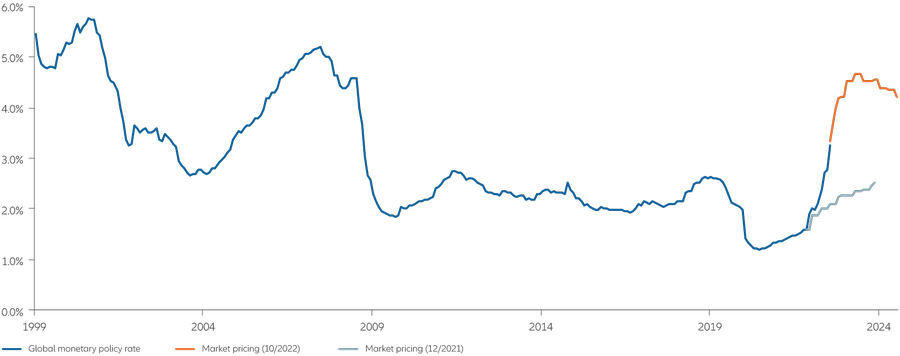
Source: Allianz Global Investors Global Economics & Strategy, Bank for International Settlements, Bloomberg. Data as at 20 October 2022.
1 The last time major US equity and bond indices both dropped for the year was 1994. Source: Stocks and Bonds are Falling in Lockstep at Pace Unseen in Decades, The Wall Street Journal, 3 May 2022
2 Source: China is sticking to its ‘zero Covid’ policy, New York Times, 16 October 2022

“Market conditions have become more conducive to tactical and relative-value positioning, seeking to profit incrementally from cross-country and cross-asset spread moves across the yield-curve spectrum.
Once inflation and core rates stabilise, we see spread assets following soon after.“
Franck Dixmier
Global CIO Fixed Income
Fixed-income strategy: time to re-engage with markets in 2023?
After such a historic reset in global bond markets, a key question in investors’ minds is how to re-engage with fixed income going into 2023. The macro picture remains challenging. Core inflation may prove to be stickier than previously anticipated, although as economies slow down, the headline inflationary uptrend is likely to ease somewhat. But tail risks still lurk. Markets may have misjudged monetary policy on two fronts: first, the level at which rates will have to rise, and stay for some time, to stabilise and bring down inflation; and second, the extent to which quantitative easing through asset purchases will have to be wound down.
Going forward, we expect central banks will be hard-pressed to shake off any market perception of their role as “bond market-makers” or “fiscal-policy underwriters” of last resort. As expectations around liquidity and “fiscal dominance” come to an end, expect bouts of market volatility to be the dominant feature of the months ahead.
Our proprietary leading indicators forecast that global growth continues to run below its trend rate over the coming months. A global recession is increasingly likely, given headwinds from tightening financial conditions and the squeeze in household real incomes. For emerging-market economies, where inflation is showing early signs of moderating and many central banks are close to the end of their tightening cycles, the sharp appreciation of the US dollar and a squeeze in global dollar liquidity are unhelpful.
Consider investments aimed at minimising rate, spread and currency volatility
While the outsized sell-off in UK government debt in October 2022 was highly idiosyncratic in some respects, it meant investors could add “financial stability” to a list of tail risks that already includes “sticky inflation” and “deep recession”. The outlook for bonds has got messier – measures of implied and realised bond volatility remain too high and highly unstable for taking much outright, one-directional risk in portfolios (see Exhibit 2). Ideas to think about:
- Considering the inherent macro uncertainty at this point of the rates and credit cycle, it may be the wrong time to aggressively increase outright duration or credit risk.
- Many government bond yield curves are flattish to inverted, so buying short-maturity bonds could lock in yield income as high as – or even higher than – that offered by long-maturity debt. But short-maturity bonds may not help much to dampen portfolio volatility as the front-end of yield curves remains vulnerable to further shocks from the repricing of terminal short-term rates.
- We think investors should consider combining short-maturity cash bonds with derivatives-based overlay strategies that can help minimise rate, spread and currency volatility. It’s important to note that there can be cash outlay and performance costs associated with these hedging strategies.
- Floating-rate notes are another way to add exposure to short-duration corporate debt with less interest rate risk. Keep in mind that floater yields tend to be lower than fixed-rate corporate bond yields – it would take several consecutive rate hikes for floater yields to begin to catch up.
Exhibit 2: measures of expected and realised bond volatility have come down from their recent peaks, but are still high
Realised volatility (30 days trailing) of global investment-grade bonds and option-implied volatility (30 days ahead) of US Treasury bonds
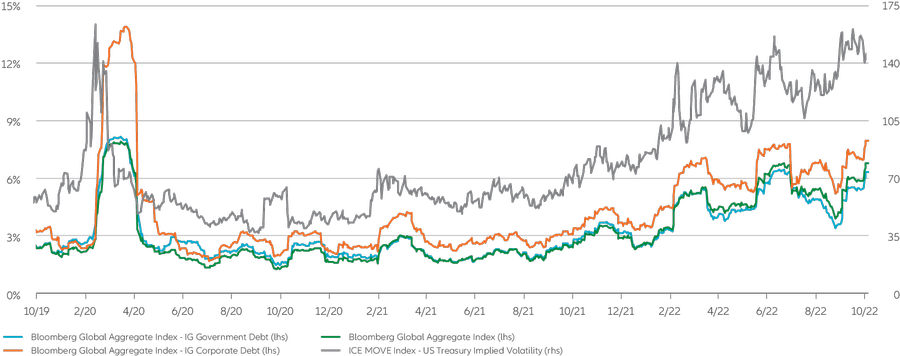
Source: Bloomberg and ICE BofA indices. Allianz Global Investors. Data as at 31 October 2022. Index returns in USD (hedged). Realised volatility (30 days trailing) is annualised. IG= bonds rated Investment Grade. lhs=left-hand-side axis. rhs=right-hand-side axis. The rhs axis represents the value of the MOVE. which is a yield curve-weighted index of the normalised implied volatility on 1-month Treasury options on the 2, 5, 10 and 30-year contracts over the next 30 days. A higher MOVE value means higher option prices. Past performance does not predict future returns. See the disclosure at the end of the document for the underlying index proxies and important risk considerations. Investors cannot invest directly in an index. Index returns are presented as net returns, which reflect both price performance and income from dividend payments, if any, but do not reflect fees, brokerage commissions or other expenses of investing.
Opportunities of a flight to safety
The shift to an inflation-led regime (as opposed to a growth-led regime) is beginning to enrich the opportunities for flexible bond strategies that could benefit from pricing discrepancies across global markets. Market conditions have become more conducive to tactical and relative-value positioning, seeking to profit incrementally from cross-country and cross-asset spread moves across the yield-curve spectrum.
Some central banks are further along the rate-hiking cycle than others, and we are beginning to see early signs of greater divergence in monetary policy expectations. Investors may soon want to allocate more strategically – but incrementally – to those core rates markets that could potentially benefit from a flight to safety. These include markets where substantial rate hikes have already been delivered, positive real yields can be found further down the yield curve, and terminal interest-rate expectations (ie, the peak before rates fall back) are high compared to the perceived neutral rate.
Watch for unorthodox outcomes
There’s also quantitative tightening to consider. If central banks go ahead and accelerate the run-off of their bond holdings, liquidity conditions could turn sour and longer-dated bonds might not behave as expected in a flight-to-safety scenario.
The gilt market turmoil raised another, more unorthodox, possibility. While continuing to hike short-term rates, central banks may have to delay quantitative tightening as a way to restore liquidity at the long end of the curve. They might argue that bond purchases in that context are not inflationary as they do not necessarily encourage lending and spending. Bond and currency markets may beg to differ and nonetheless come under pressure.
Where to move next? Investment-grade credit for starters
Once inflation and core rates stabilise, we see spread assets following soon after. The credit cycle has barely begun to turn and the full impact of falling consumer demand on corporate sectors has started to show only recently. Market downturns usually require patience, with historical analysis suggesting that three months into a recession provides a possible entry point to add more risk to investment-grade credit. Other potential opportunities to watch include:
- Yields offered by sustainability-labelled debt, such as green bonds mostly issued in the investment-grade space, have reset to more competitive levels. We see the energy crisis boosting long-term demand and yield for green and social financing – even if, in the short-term, there’s a move to more polluting sources and energy bill caps to avert a cost-of-living crunch.
- High-yield corporate bonds and emerging-market external debt have regained value and offer ample income cushion and potentially attractive long-term returns. But such assets may pose greater volatility and default-rate risks, so active management is key.
Fundamentals are a lot better than heading into previous recessionary periods, but there’s still uncertainty over terminal policy rates and the fallout for growth. Our outlook continues to favour underweight beta positioning in fixed income – with a view to reducing this underweight gradually through higher-quality issuers and by allocating freely across geographies.

“We are approaching the point when bad news for the economy could become good news for equity markets… Get set for a future where interest rates likely need to be higher than in the past decade in a “new old normal” where money has a cost again.
2023 could be an opportunity to position portfolios for the long term.“
Virginie Maisonneuve
Global CIO Equity
Equity strategy: adjusting to the “new old normal”
2022 saw the fastest tightening of monetary conditions in 40 years as central banks sought to avoid a 1970s-style “anchoring” of inflation expectations. Markets took some time to appreciate how aggressive policy makers were prepared to be, but the measures taken are already helping to cool inflation and will set the stage for capital markets in 2023.
Given its relative economic strength and energy resilience, the US has the capacity to absorb more dramatic monetary tightening than some other countries. Such a strong dose of medicine aids the fight against inflation, but it can also have global consequences. It has helped to sharply suppress demand, increase the recession risk, and create stresses in currency markets and elsewhere.
Already we are seeing the global outlook grow more divergent, with China experiencing slow growth and low inflation and Europe weakened by its structural dependency on Russian gas.
Geopolitical, supply chain and demographic shifts may raise costs but offer investment potential
The future ecosystem for capital markets will likely look quite different from the one that has prevailed over the past decade. Deflationary factors such as the expanding global supply chain that brought China’s manufacturing power to the world or the smooth transfer of technology between regions and nations will face new challenges. Other geopolitical shifts could have major ramifications, including China’s evolution towards a major third phase of its modern development, where it hopes to combine continued economic success with “soft power” influence.
Global supply chains are being redesigned along trust lines and onshoring is increasingly common. Technologies such as artificial intelligence (AI) are now being adopted well beyond just the technology sector, which is creating a “survival of the fittest” competitive environment – a phenomenon we call “digital Darwinism”. All these factors – as well as an overall ageing demographic – might help to create additional frictional costs and put a floor on inflation.
In addition, the path towards a renewable energy future could be volatile at times and require significant recalibration. Get set for a future where interest rates likely need to be higher than in the past decade in a “new old normal” where money has a cost again.
2023 could be an opportunity to position portfolios for the long term
Investors might want to look out for the following cues:
- Prepare for the potential equity market turnaround: in the short term, we are approaching the point when bad news for the economy could become good news for equity markets as weakening economic activity will start to lean on inflation. This could bring a slower pace of rate increases – and eventually a peak in rates in 2023 – accompanied by recession.
- Expect earnings adjustments: corporate earnings expectations (see Exhibit 3) still need to come down – perhaps significantly in some cases – to reflect the recessionary environment, rising inventories, increasing input costs and rates, and a stronger US dollar. Furthermore, expectations need to adjust to a world in which money has a cost again. Growth can no longer be funded with limitless debt, and the threshold for the return on capital employed must rise. Ultimately, this development is healthy and may promote the survival of the fittest, favour quality companies and balance sheets, and boost income for some.
- See volatility as a potential opportunity: regime shifts tend to bring volatility and disruption, creating an environment for active stock pickers rather than passive investments. Amid volatility in 2023, investors should explore opportunities to position portfolios for the long term. First, consider anchoring portfolios with low-volatility multi-factor strategies that offer a possible bedrock of stability on which to build. Second, explore quality value and growth opportunities as well as income. Finally, consider high-conviction thematics around key pillars such as national security (eg, food, energy, water, cyber security), climate resilience and innovation (eg, AI) and sustainability. According to the International Energy Agency (IEA), achieving net-zero emissions by 2050 will require annual investment in clean energy worldwide to more than triple by 2030 to around USD 4 trillion.3 Accordingly, the investment landscape is forecast to shift from one that is focused on commodities like oil and gas to renewables and the raw materials needed to deliver them. Arguably, the world has never experienced an energy transformation on this scale.
- Watch for key signals: in addition to the evolution of inflationary pressures, we see three important signals to watch in 2023: i) developments in the US labour market – we think the US Federal Reserve might be comfortable with a rise in unemployment from 3.5% to above 4%, ii) how Europe copes with the unfolding energy crisis, and iii) the adjustments that China makes to policy following the National People’s Congress in March 2023 and the growth model the country adopts.
Exhibit 3: after the massive earnings per share rally in 2021, earnings expectations for 2023 and 2024 are looking downbeat, but may adjust further
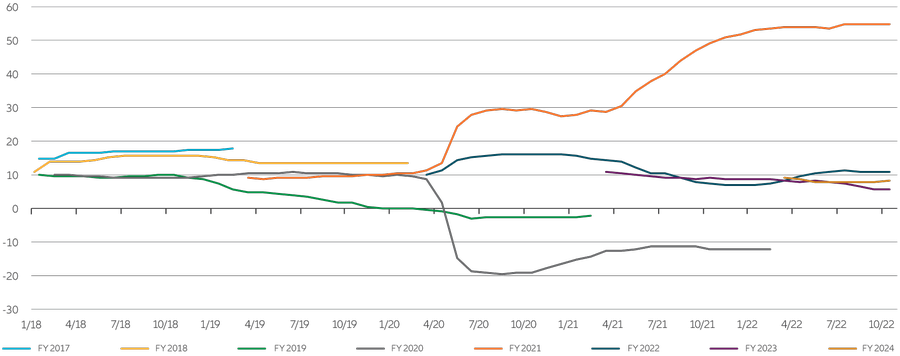
Source: Refinitiv Datastream. Data as at 1 November 2022.
3 Source: Net Zero by 2050: A Roadmap for the Global Energy Sector, IEA, October 2021

“Our Multi Asset expert group sees a light at the end of the tunnel, starting in fixed-income assets.
Overall, our 2023 outlook favours a flexible approach to portfolio positioning as investors manage the transition from an inflationary to a recessionary environment.“
Gregor MA Hirt
Global CIO Multi Asset
Multi-asset strategy: potential safe havens emerge
It has been a tough time for markets. Balanced portfolios of bonds and equities have experienced a rare correlation of underperformance. Core inflation remains high and market expectations for longer-term inflation are still too low in our view. And it is clear the US Federal Reserve will use financial wealth destruction to weaken demand. But our Multi Asset expert group sees a light at the end of the tunnel, starting in fixed-income assets:
- Government bonds, particularly US Treasuries, could offer the first opportunities and start to appear attractive for investors seeking longer-term expected returns. Investors will be hoping for a repeat of the historical pattern of government bonds outperforming other asset classes when inflation comes down from high levels.
- TINA, the familiar adage about buying equities – “there is no alternative” – is no longer the case. And investor surveys4 indicate record-high cash levels on the side lines. Some long-term investors could likely reallocate to fixed income once bond volatility steadies.
- With corporate investment-grade bonds, we prefer to err on the side of caution for the time being. This is particularly the case in Europe, given the recessionary fears resulting from the surge in energy prices. Credit spreads may widen further and could offer enticing entry points – but we know such widening episodes tend to be short-lived.
Timing equity market re-entry is dependent on a recession
For equity markets, valuations have become more appealing but mostly because prices have adjusted. Investors should consider:
- Earnings expectations remain relatively high, especially in the US, and we think there is scope for them to come down.
- European markets — where valuations seem fairer — are at risk from a longer and deeper recession than is likely in the US. It will take another round of market weakness for our Multi Asset team to justify a more constructive stance.
Perfect timing is impossible to predict. But historically, the first half of a recession, which we expect in the US in 2023, could offer a potential entry point as it tends to be when prices begin to bottom out. This is especially the case if the US Federal Reserve continues, as expected, to aggressively tighten its monetary policy.
Energy commodities sustain support, despite a recessionary environment
Relatively speaking, we tactically prefer US high yields versus US equities because of carry and valuation preferences (see Exhibit 4). From a sector perspective, we continue to like energy, global healthcare, and the US financial sector.
Commodities are proving to be more resilient than many investors had expected, particularly in the energy sector. A recessionary environment is usually not optimal for the asset class, but the geopolitical landscape provides unusual support:
- The war in Ukraine – which we expect to last well into 2023.
- Lack of investment in “brown” energies like fracking over recent years.
- The move to decarbonisation will help gas prices.
- Finally, OPEC seems to be very inclined to have a higher-for-longer oil price over the coming quarters, notwithstanding US pressure on Saudi Arabia.
Caution is warranted until the dollar steadies
A key factor for the months to come will be the path of the US dollar. The currency is overvalued, but we think it could appreciate further as research indicates that currencies sometimes overshoot their fair value for longer periods. Its main support comes from a relative terms of trade advantage. Combined with still-high energy prices, the strong US dollar could become an increasing challenge for some weaker emerging markets. The International Monetary Fund’s lending has already reached USD 140 billion5 – a record high in the wake of higher interest rates, elevated commodity prices, and a global economic slowdown.
Differences in interest rate paths in many countries may now offer an opportunity for attractive returns, but we remain cautious for the time being and wait for the US dollar to stabilise. For longer-term investors, we think that Asian high yields might offer some value versus global ones.
Overall, our multi-asset outlook favours a flexible approach to portfolio positioning as investors manage the transition from an inflationary to a recessionary environment.
Exhibit 4: as safe havens replace “equities as the only option”, US stocks have an absolute and relative value challenge
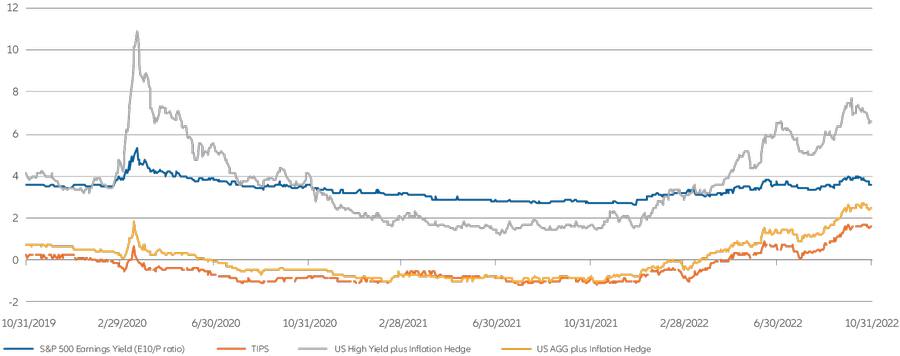
Source: Bloomberg. Data as at 31 October 2022.
4 The number of participants in the Bank of America Fund Manager Survey who are overweight equities hit an all-time low, according to the bank’s monthly survey for September. Source: "Super bearish" fund managers' allocation to global stocks at all-time low, Bank of America survey shows, Reuters, 22 September, 2022
5 Source: IMF bailouts hit record high as global economic outlook worsens, Financial Times, 25 September 2022

“Markets might react poorly if the Fed holds steady even after inflation falls, but that could be an opportunity to take advantage of short-term selloffs.
While we expect to see a prolonged period of risk market volatility until interest rates level off, higher-quality income-generating investment strategies may be able to generate attractive returns.“
Matt Toms
Global CIO, Voya Investment Management
Guest viewpoint: Voya Investment Management
View from the US: peaking rates could signal cresting volatility
Much of the upheaval in the financial markets in 2022 was driven by interest rates, and the US Federal Reserve did most of the driving. Investors everywhere feel like passengers on an unpleasantly bumpy ride, trying to hang on while they anticipate the Fed’s next move. But while it’s important to stay focused on the long term, it would be a mistake to miss the signs right outside the window. Here’s what we mean:
- The US economy is still humming along, and economic resilience is good for consumers and corporations. What’s more, the Fed will want to see lower inflation and a notably slower US economy before cutting rates. Markets might react poorly if the Fed holds steady even after inflation falls, but that could be an opportunity to take advantage of short-term selloffs.
- The economic cycle is real, so don’t be surprised to see a mild US recession at some point in 2023. Jobs numbers could get a little worse (though possibly not enough to justify a rate cut) and corporate earnings are poised to contract. These ultimately healthy developments could set up the next phase of the cycle and help limit the severity of the economic downdraft – provided there are no significant imbalances (bubbles) in the US economy.
- There’s a lot to be said for finding a steady income stream during a period of volatility, and fixed income investors may be able to get higher yields for less overall risk. High-quality income-producing assets are a great place to be right now.
- Corporate profit margins have room to come down, even if the financial markets won’t like it. Following the recent compression of price-to-earnings (P/E) multiples, the quality of the “E” will grow increasingly important. What we’ve seen so far is a revaluation of asset prices largely driven by rates, not fears of a dark economic downside.
- The US dollar has become a high-yielding currency, with the Fed repeatedly trying to curb inflation with strict monetary policy. We expect the dollar to remain strong, but if long-term interest rates were to peak, that could remove a key factor driving both the dollar’s value and the market’s volatility.
Top ideas for 2023: higher-quality income streams and US equities
For fixed-income investors, there’s one silver lining to the great bond rout: more yield for less risk (see Exhibit 5). We’re seeing attractive yields and short durations on asset-backed securities (including bundled car loans and credit cards) and mortgage-backed securities (backed by government-owned lenders such as Fannie Mae). Investment-grade corporates have also sold off, pushing their yields higher, while their shorter durations make them less volatile. Investors should note that investing in non-government bonds does involve credit risk, including the risk of default. And all bonds include some degree of interest rate risk, which rises along with a bond’s duration.
Equity market volatility is creating opportunities within both US large caps and small caps. Bigger firms tend to better withstand prolonged inflation and have more durable earnings streams, while small caps are trading at a discount to large caps and could rebound if today’s severely oversold conditions unwind. Of course, any investment in stocks can be volatile, as the markets have repeatedly shown. This is particularly true with small caps, which tend to fluctuate in value more than large caps. Looking outside the US, other regions appear less attractive when compared with the US’s relative economic strength, even at depressed valuation multiples.
The bottom line? While we expect to see a prolonged period of risk market volatility until interest rates level off, higher-quality income-generating investment strategies may be able to generate attractive returns.
Exhibit 5: there’s a silver lining for bond investors: more yield for less risk
US yields by credit quality (2012-2022)
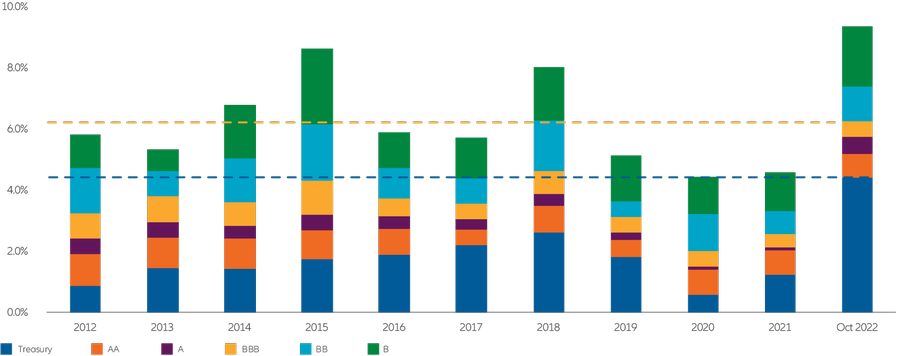
Source: Bloomberg Index Services Limited and Voya Investment Management. Treasuries represented by the Bloomberg US Treasury Index. Yields by credit quality represented by the Bloomberg US Corporate Aa, A and Baa subindices and the Bloomberg US High Yield Corporate 2% Issuer Cap Ba and B subindices. The blue dashed line represents the US Treasury Index yield as at 31 October 2022 and the yellow dashed line represents the Bloomberg US Corporate Baa Index yield as at 31 October 2022.
Allianz Global Investors (AllianzGI) and Voya Investment Management (Voya IM) have entered into a long-term strategic partnership, and as such, as of 25 July 2022, the investment team transferred to Voya IM and Voya IM became the delegated manager for the Allianz Fund referenced in this presentation. AllianzGI continues to provide information and services to Voya IM for this investment through a transitional service agreement. None of the composition of the team’s investment professionals, the investment philosophy nor the investment process have changed as a result of these events. Allianz Global Investors GMBH is the manager for the Allianz Fund represented in this presentation and Voya IM is the sub-advisor.
-
Diversification does not guarantee a profit or protect against losses.
Investing involves risk. The value of an investment and the income from it will fluctuate and investors may not get back the principal invested. Past performance is not indicative of future performance. This is a marketing communication. It is for informational purposes only. This document does not constitute investment advice or a recommendation to buy, sell or hold any security and shall not be deemed an offer to sell or a solicitation of an offer to buy any security.
The views and opinions expressed herein, which are subject to change without notice, are those of the issuer or its affiliated companies at the time of publication. Certain data used are derived from various sources believed to be reliable, but the accuracy or completeness of the data is not guaranteed and no liability is assumed for any direct or consequential losses arising from their use. The duplication, publication, extraction or transmission of the contents, irrespective of the form, is not permitted.
This material has not been reviewed by any regulatory authorities. In mainland China, it is for Qualified Domestic Institutional Investors scheme pursuant to applicable rules and regulations and is for information purpose only. This document does not constitute a public offer by virtue of Act Number 26.831 of the Argentine Republic and General Resolution No. 622/2013 of the NSC. This communication's sole purpose is to inform and does not under any circumstance constitute promotion or publicity of Allianz Global Investors products and/or services in Colombia or to Colombian residents pursuant to part 4 of Decree 2555 of 2010. This communication does not in any way aim to directly or indirectly initiate the purchase of a product or the provision of a service offered by Allianz Global Investors. Via reception of his document, each resident in Colombia acknowledges and accepts to have contacted Allianz Global Investors via their own initiative and that the communication under no circumstances does not arise from any promotional or marketing activities carried out by Allianz Global Investors. Colombian residents accept that accessing any type of social network page of Allianz Global Investors is done under their own responsibility and initiative and are aware that they may access specific information on the products and services of Allianz Global Investors. This communication is strictly private and confidential and may not be reproduced. This communication does not constitute a public offer of securities in Colombia pursuant to the public offer regulation set forth in Decree 2555 of 2010. This communication and the information provided herein should not be considered a solicitation or an offer by Allianz Global Investors or its affiliates to provide any financial products in Brazil, Panama, Peru, and Uruguay. In Australia, this material is presented by Allianz Global Investors Asia Pacific Limited (“AllianzGI AP”) and is intended for the use of investment consultants and other institutional/professional investors only, and is not directed to the public or individual retail investors. AllianzGI AP is not licensed to provide financial services to retail clients in Australia. AllianzGI AP is exempt from the requirement to hold an Australian Foreign Financial Service License under the Corporations Act 2001 (Cth) pursuant to ASIC Class Order (CO 03/1103) with respect to the provision of financial services to wholesale clients only. AllianzGI AP is licensed and regulated by Hong Kong Securities and Futures Commission under Hong Kong laws, which differ from Australian laws.
This document is being distributed by the following Allianz Global Investors companies: Allianz Global Investors U.S. LLC, an investment adviser registered with the U.S. Securities and Exchange Commission; Allianz Global Investors Distributors LLC, distributor registered with FINRA, is affiliated with Allianz Global Investors U.S. LLC; Allianz Global Investors GmbH, an investment company in Germany, authorized by the German Bundesanstalt für Finanzdienstleistungsaufsicht (BaFin); Allianz Global Investors (Schweiz) AG; in HK, by Allianz Global Investors Asia Pacific Ltd., licensed by the Hong Kong Securities and Futures Commission; in Singapore, by Allianz Global Investors Singapore Ltd., regulated by the Monetary Authority of Singapore [Company Registration No. 199907169Z]; in Japan, by Allianz Global Investors Japan Co., Ltd., registered in Japan as a Financial Instruments Business Operator [Registered No. The Director of Kanto Local Finance Bureau (Financial Instruments Business Operator), No. 424], Member of Japan Investment Advisers Association, the Investment Trust Association, Japan and Type II Financial Instruments Firms Association; in Taiwan, by Allianz Global Investors Taiwan Ltd., licensed by Financial Supervisory Commission in Taiwan; and in Indonesia, by PT. Allianz Global Investors Asset Management Indonesia licensed by Indonesia Financial Services Authority (OJK).
2556494











